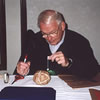Solar Eclipse Sites
Sites About the August 11, 1999 Solar Eclipse
 August 11, 1999, Solar Eclipse Images
August 11, 1999, Solar Eclipse Images
 Goddard News for August 6, 1999 View an Eclipse on the Internet
Goddard News for August 6, 1999 View an Eclipse on the Internet
 BBC Online: Solar Eclipse Lots of information about the eclipse
BBC Online: Solar Eclipse Lots of information about the eclipse
 Eclipse on August 11, 1999. Information on the coming solar eclipse.
Eclipse on August 11, 1999. Information on the coming solar eclipse.
 Eclipse 1999 Includes a map of the exact path of the eclipse.
Eclipse 1999 Includes a map of the exact path of the eclipse.
 Laupheim Observatory Includes a countdown to the solar eclipse.
Laupheim Observatory Includes a countdown to the solar eclipse.
 Live! Eclipse Will provide images of the solar eclipse live in both English and Japanese.
Live! Eclipse Will provide images of the solar eclipse live in both English and Japanese.
 NASA's Solar Eclipse 99 Includes information about viewing the eclipse live on their web site.
NASA's Solar Eclipse 99 Includes information about viewing the eclipse live on their web site.
 Solar Eclipse '99 Chat Chat about the solar eclipse!
Solar Eclipse '99 Chat Chat about the solar eclipse!
General Information About Solar Eclipses
 Kidseclipse: The Millennial Eclipse Web site devoted to teaching kids about the solar eclipse.
Kidseclipse: The Millennial Eclipse Web site devoted to teaching kids about the solar eclipse.
 Past Solar Eclipses List of previous solar eclipses.
Past Solar Eclipses List of previous solar eclipses.
 Solar Eclipse Windows to the Universe solar eclipse page.
Solar Eclipse Windows to the Universe solar eclipse page.
 Solar Eclipse Image Archive
Solar Eclipse Image Archive
 The history behind solar eclipses
The history behind solar eclipses
 Viewing Solar EclipsesAdvice on safely viewing a solar eclipse.
Viewing Solar EclipsesAdvice on safely viewing a solar eclipse.
Information about the Sun
 Our Quickie Question Archive Includes many answers to various Sun questions.
Our Quickie Question Archive Includes many answers to various Sun questions.
 Solar Mythology Many myths are about the Sun.
Solar Mythology Many myths are about the Sun.
 Sun
Sun
You might also be interested in:
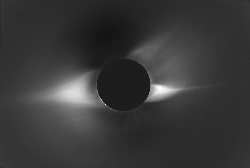
The last solar eclipse of this millennium was on August 11, 1999. Only people in Europe, the Middle East and India could see it. This was a total solar eclipse, which means that the Moon completely blocked
...more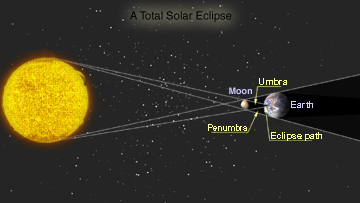
An eclipse of the Sun occurs when the Earth passes through the moon's shadow. A total eclipse of the Sun takes place when the Moon is directly between the Sun and the Earth. When a total eclipse does
...more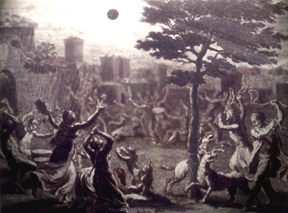
Solar eclipses are really great to watch! But in the past, people were very scared of them. They didn't understand what was going on. Some people thought that a monster or animal was eating the Sun! They
...more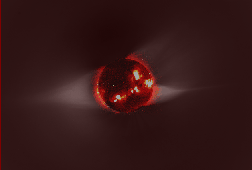
Rising above the Sun's chromosphere , the temperature jumps sharply from a few tens of thousands of kelvins to as much as a few million kelvins in the Sun's outer atmosphere, the solar corona. Understanding
...more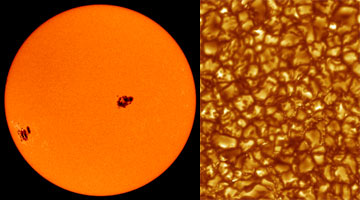
Most of the energy we receive from the Sun is the visible (white) light emitted from the photosphere. The photosphere is one of the coolest regions of the Sun (6000 K), so only a small fraction (0.1%)
...more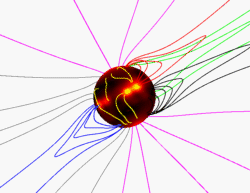
The gas in the solar corona is at very high temperatures (typically 1-2 million kelvins in most regions) so it is almost completely in a plasma state (made up of charged particles, mostly protons and electrons).
...more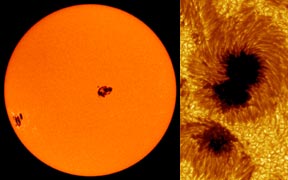
Sunspots are dark spots on the Sun. They may look small, but they are actually as bigas a planet like Earth or Mars! Sunspots are "dark" because they are colder than the areas around them. Of course, they
...more
 August 11, 1999, Solar Eclipse Images
August 11, 1999, Solar Eclipse Images Goddard News for August 6, 1999 View an Eclipse on the Internet
Goddard News for August 6, 1999 View an Eclipse on the Internet BBC Online: Solar Eclipse Lots of information about the eclipse
BBC Online: Solar Eclipse Lots of information about the eclipse Eclipse on August 11, 1999. Information on the coming solar eclipse.
Eclipse on August 11, 1999. Information on the coming solar eclipse. Eclipse 1999 Includes a map of the exact path of the eclipse.
Eclipse 1999 Includes a map of the exact path of the eclipse. Laupheim Observatory Includes a countdown to the solar eclipse.
Laupheim Observatory Includes a countdown to the solar eclipse. Live! Eclipse Will provide images of the solar eclipse live in both English and Japanese.
Live! Eclipse Will provide images of the solar eclipse live in both English and Japanese. NASA's Solar Eclipse 99 Includes information about viewing the eclipse live on their web site.
NASA's Solar Eclipse 99 Includes information about viewing the eclipse live on their web site. Solar Eclipse '99 Chat Chat about the solar eclipse!
Solar Eclipse '99 Chat Chat about the solar eclipse! Kidseclipse: The Millennial Eclipse Web site devoted to teaching kids about the solar eclipse.
Kidseclipse: The Millennial Eclipse Web site devoted to teaching kids about the solar eclipse. Past Solar Eclipses List of previous solar eclipses.
Past Solar Eclipses List of previous solar eclipses. Solar Eclipse Windows to the Universe solar eclipse page.
Solar Eclipse Windows to the Universe solar eclipse page. The history behind solar eclipses
The history behind solar eclipses Viewing Solar EclipsesAdvice on safely viewing a solar eclipse.
Viewing Solar EclipsesAdvice on safely viewing a solar eclipse. Our Quickie Question Archive Includes many answers to various Sun questions.
Our Quickie Question Archive Includes many answers to various Sun questions. Solar Mythology Many myths are about the Sun.
Solar Mythology Many myths are about the Sun.

